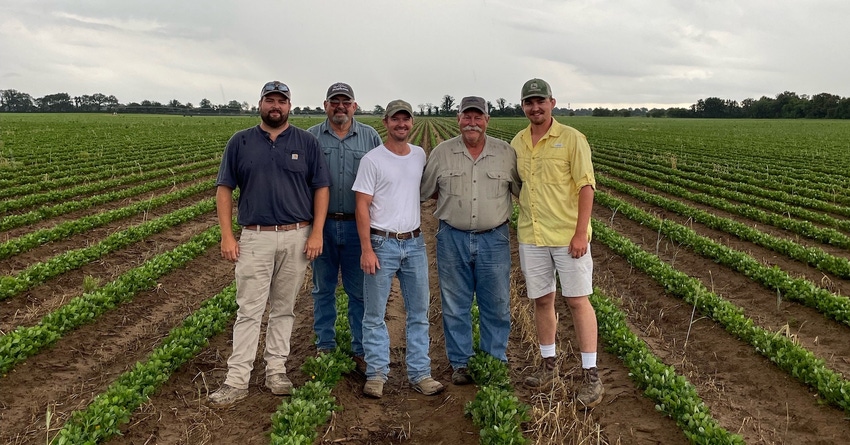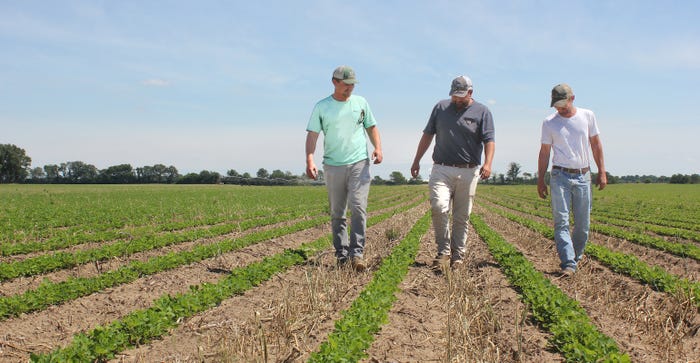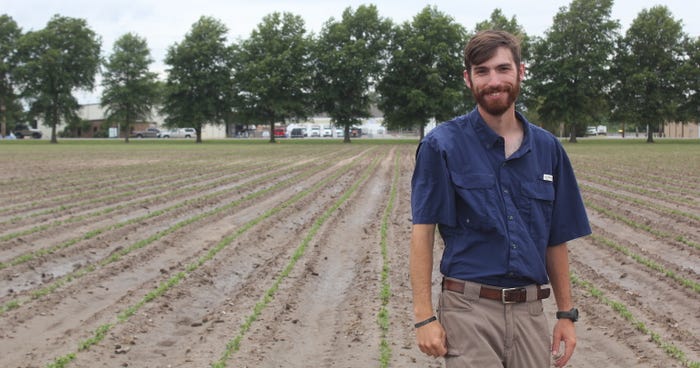
Sikeston, Mo., is a long way from the Deep South and the heart of peanut production country, but don’t bother telling that to the Deane family.
Brothers Bill and Mark Deane and their sons, Clay, Matt and Hunter, have been successfully growing peanuts on their row crop operation, Triple D Farms, for the past seven years. In fact, they were some of the first farmers in Missouri to grow peanuts commercially since the early 1980s.
“We didn’t know if it would work, but then nothing else was really working at the time,” said Matt Deane as he recalled the depressed farm economy of 2015. His cousin Clay had just returned to the farm after graduating from Mississippi State University where he had learned about peanut production and developed some connections within the peanut industry. Even though they had no equipment and there was little infrastructure in the area, the family decided to take a risk and give peanuts a shot.
It turned out to be a good gamble. The first 250-acre crop was an excellent one, according to the Deanes. They had proven you could grow a quality peanut crop at the northernmost reaches of the Cotton Belt.
“At the time, we were farming a lot of sandy ground, and we felt like our yields on other crops were really limited on those sandy soils,” Matt said.
“But they were a perfect fit for peanuts,” he added.
This spring the family planted roughly 900 acres of peanuts. As the Deanes have increased their peanut acreage, the profitability of the crop has allowed their farm to thrive. Triple D Farms has grown from 3,500 acres since the first peanuts went in the ground, to more than 8,000 acres today.
“It’s a very different picture than it was in 2015, and in a way, peanuts saved us,” said Clay Deane. “They carried a lot of weight when nothing else would. They paid for themselves and kept things afloat. They came at a great time for our farm.”
Missouri peanut production
The Deanes are just one example of Missouri farmers who have embraced peanut production over the past decade. Peanut acreage has been increasing steadily in the state. In 2020, USDA designated Missouri as a primary peanut-producing state under the Peanut Promotion, Research and Information Order (Order). Under the Order, primary peanut-producing states must maintain a three-year average production of at least 10,000 tons of peanuts. Clay Deane now represents Missouri on the National Peanut Board.
USDA-NASS does not provide peanut production estimates for the state of Missouri, but Justin Calhoun, soils and cropping systems specialist for University of Missouri Extension, estimates 2022 peanut acreage in the Show-Me State may be close to 25,000 acres.
No, it’s not Georgia numbers, but still a significant increase over a short time. Even more impressive when you consider production is confined to a handful of counties in the Bootheel region.
The 2019 formation of Delta Peanut, a farmer-owned cooperative with a warehouse and shelling operation in Jonesboro, Ark., most likely created the biggest spark for increasing acreage in the region, according to the Deanes.
“Before Delta, all peanuts had to be shipped to Texas or Georgia to be shelled. There were a couple of buying points in the area, but they were at max capacity. There couldn’t be any more acres in our area because there was nowhere else for them to go,” Clay said. “When Delta came in it did allow for more acres.”
Delta Peanut is currently completing a buying point, shelling and blanching facility in Kennett, Mo.
Growing peanuts in Missouri
Marketing infrastructure closer to home has made peanut production more attractive in the Bootheel, but to get the crop to market, growers there must overcome production challenges unique to their region – namely timeliness.

“Our biggest issue is getting varieties that will do well in our short window,” Clay said. “Planting has to be done. There’s no wiggle room. That’s even more true with harvest. We dig more on the calendar than we do on the status of the crop. Not that we don’t look at that every year, but sometimes it doesn’t matter. When it gets to a certain date on the calendar we have to start harvesting because we’re not going to get the crop out if we don’t.”
Peanut planting typically runs late April through the first week of May. Harvest begins on Sept. 15.
“We have waited until Sept. 20. On the years we’ve done that, we try to tell ourselves to remember to start on the 15th next year,” Matt said. “Five days can make or break a crop.”
New crop challenges
Another challenge for Missouri producers is the lack of generational knowledge in peanut production as opposed to a crop like cotton. As with any new crop, equipment, seed varieties and chemistries are for the most part new territory for growers and their work crews.
“We bought a peanut digger sight unseen from Georgia. We weren’t even sure what a peanut digger looked like,” Matt said jokingly, “but we drug it home determined to make it work.”
“That is what made us most uncomfortable the first year. We didn’t have anyone to fall back on. There weren’t any peanut scouts.”
“You could call someone in Georgia, but we quickly learned what works in Georgia doesn’t always work up here,” Hunter added.
Fortunately, the Deanes had help. Alex Mayfield, a college friend who later married into the family, worked in the industry and helped plant and harvest that first crop and advised them on their spray program.
The Deanes also credit the late Gordon Drennan, who worked with Golden Peanut in Arkansas as being a valuable resource and a trusted mentor who also became a dear friend.
“We wouldn’t have been able to do it without Gordon and Alex,” Matt said.
New research
As the state’s industry grows, so do opportunities for Missouri-specific research and education. This year the National Peanut Board, along with the newly formed Missouri Peanut Producers Association approved their first checkoff-funded research projects with the University of Missouri.

Calhoun is the lead investigator of three peanut projects that will evaluate yield response to different seeding rates; the influence of plant growth regulator on growth and yield; and the efficacy of in-season gypsum applications in the Missouri soils.
“A lot of this work has been done in the South, but because we’re at the northernmost reaches of peanut production, conclusions drawn in Georgia and Florida may not necessarily be what we see here,” Calhoun said.
The research will take place at two sites of the Fisher Delta Research, Extension and Education Center in Portageville, Mo. Calhoun made sure to give portions of his peanut research some road frontage.
“I want our Missouri growers that pass by the Center to realize there’s something new here,” he said.
“That’s the thing about growers in the Missouri Bootheel. They are early adopters. When they see an opportunity to be the first to do something, they’re going to jump on it. I feel like that’s what they’ve done with peanut,” he added.
About the Author(s)
You May Also Like






